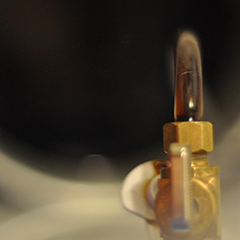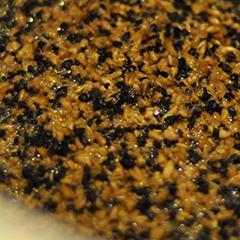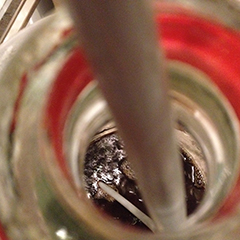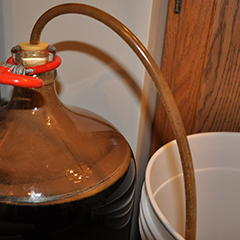
In preparation for the two brews I did (check out Brew Six-B), I read up on advanced brewing in my handbook: The Complete Joy of Home Brewing by Charlie Papazian. I have the 2nd edition (1991); the fourth came out this year. In it I gained a much deeper understanding of what happens during the mash and the boil.

In the mash (the process with hot water and grains), the starches from the malted grains are turned into sugars with the help of enzymes. Not all malted grains have the enzymes required - these are called adjunct grains. It's important not to have too many of these as not much sugar will appear in the wort (sugar water). Various grains bring different flavours and colours to the beer. The flavours often happen via the way the barley, wheat, oats, rice, etc. are malted - this is where all the names for the barley come from (2-row, crystal, chocolate, munich, black, etc.).
Each grain contributes to the colour of the beer. The darkness of the malt is expressed in ˚L or SRM (Standard Reference Method). I was so surprised at how dark my wort came out with only 2.25 lbs of really dark malt of 17.25 lbs of grain.

Hops are way more complicated. Primarily, they are used in bittering the wort - helping to remedy the sweetness of beer. The more malt (sugar), the more hops are needed. In this recipe, I have extracted an enormous amount of malt, so I have to use some hops with high alpha acids. The longer you boil them, the more the acids attach to the malt.
Then there are the hop oils. The oils dissipate very quickly in the boil, but the hops need to be boiled in order to extract them. To get these oils, hops are added at the very end of the boil for 1-5 minutes. The hop oils are what contribute to hoppy aroma and flavour.
The amount of hops used, the amount of acid and the amount of time they are in the boil determines the IBU or International Bitterness Units of the beer. High IBU doesn't necessarily mean the beer will be bitter, but it usually does. In the case of imperial stouts, a high IBU is needed to keep the malt in check.

One of the other new methods I got to try out was the cooling coil. If a brew is not cooled quickly after a boil, it can be infected with wild yeasts and bacteria which can impact the flavour of the beer. The coil is hooked up to a cold water source (ice water bucket with a pump or in my case, an outdoor tap). The water circulates through the wort in the copper pipe and emerges piping hot. It took about 20 minutes to bring the temperature down to 22˚C. It didn't hurt that it was outside in -20˚C weather.

MASH
30 min @ 52˚C; 30 min @ 70˚C; 10 min @ 75˚C14 lbs Canadian 2-Row (2˚L)
1 lb Crystal Medium (45˚L)
1 lb Roasted Barley (300˚L)
0.75 lb Black Malt (500˚L)
0.5 lb Chocolate Malt (350˚L)
BOIL 90 min
60 min 1 oz Northern Brewer 8.6% alpha
30 min 1 oz East Kent Goldings 5.8% alpha
30 min 0.5 oz Fuggles 5% alpha
20 min 1 oz Fuggles
2 min 0.5 oz Fuggles
PITCH
Wyeast 1084 Irish Ale @ 22˚C
23 Litres; 56 IBU; Original Gravity 1.073 (potential of 9.4% ABV)

I am very excited about this brew. It should be packed with flavour and punch. Incidentally, the term imperial is interchangeable with double - so it's a stout that is twice as strong. It's called imperial because the Brits would brew this strong stuff and export it to the czars in Russia.



No comments:
Post a Comment